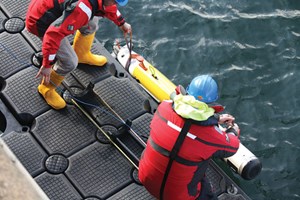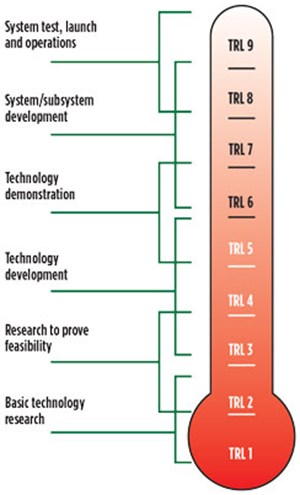Evolution of technology funding in the UK North Sea
Science and engineering organizations use a technology readiness scale (TRL) to measure innovation development and chart progress. The nine-point readiness system was originally developed by NASA in the 1970s, and was first published in 1989, Fig. 1. It has been adopted by various organizations, including the U.S. Department of Defense, the European Union, and the UK and Scottish governments. It charts projects as follows: 1) TRL 1–3 is traditionally the domain of universities; 2) TRL 3–4 is the proof-of-concept stage; and 3) at the other end of the scale is TRL 9, which defines a product ready to launch.
The challenge for many technologies is to move out of the TRL 4–8 range, which is often referred to as the “technology valley of death.” This is where proven concepts are most at risk of failing, because the technology is not scalable, or the company developing the concept fails. Not surprisingly, this stage is where most government support is focused.
HISTORICAL PERSPECTIVE
In the UK, the oil and gas industry has met its own technology development requirements for many years without the need for government intervention. Starting in 1964 with the UK Continental Shelf Act, major oil companies drilling in the North Sea deployed substantial R&D funding to meet their technology requirements. Likewise, service providers were able to obtain the capital investment required to develop tools to solve the region’s unique geological/engineering challenges from these major oil companies.
Around 2000, the Industry Technology Facilitator (ITF) was launched to help perpetuate regional momentum and expedite joint industry projects (JIPs) with oil company funding. To date, ITF members have invested £80 million and has been responsible for sponsoring more than 220 new JIPs, with 15 ongoing projects working toward conclusion.
Earlier this year, OGIC and ITF joined forces to co-fund projects, to support innovations that reduce costs, raise production efficiency and improve HSE performance. OGIC has made £1 million available, with ITF facilitating joint industry funding on behalf of its members and industry partners. The application process closed at the end of the second quarter, and both organizations are now reviewing proposals.
In addition to ITF, Scottish Enterprise, and Highlands and Islands Enterprise, have, for many years, provided support for technology development for companies based in Scotland. However, their primary objective is economic development rather than funding specific R&D efforts for technology development.
In the last ten years, this landscape has changed dramatically. The UK Offshore Operators Association started the in the early 1990s with just nine members. Its successor, Oil and Gas UK now has 65 operator members. Most of the new member companies are smaller, leaner, and tightly focused. They generally don’t have R&D budgets, and their expectation is that the supply chain will develop the appropriate solutions.
However, supply chain margins are thin, and limited R&D actually happens. There has always been a modest flow of government funding into oil and gas technology development through Innovate UK’s program of competitive calls, which seeks to support companies to develop technology. However, over the last three years, the UK and Scottish governments have launched two significant new initiatives to support oil and gas technology development.
OGIC – A SCOTTISH INITIATIVE
In 2014, the Oil and Gas Innovation Centre (OGIC) was launched with a £10.6-million allocation of funding over a 5-year period. OGIC has a specific offering—it can provide 50% to 70% grants for innovation and technology projects, on condition that the work is undertaken at a Scottish University.

The OGIC project approval process has been developed by experienced industry personnel, with OGIC’s initial process being to advise applicants whether their requirements can be supported. If OGIC can’t help, the company is “signposted” to alternative sources of funding. However, if OGIC can help, a two-page outline of the project’s requirements is circulated to all 14 universities in Scotland. Universities that possess the capability, and the capacity, respond with “expressions of interest.” The company selects which university will best suit its needs. The company and the university jointly develop the project, and the process culminates with a formal application for funding by the company to OGIC, supported by a detailed project proposal from the university.
The duration of a typical OGIC project is two to twenty months, and costs run between £20,000 and £400,000, with OGIC funding 50% to 70%. In the last three years, OGIC has supported more than 40 projects, totaling over £2.5 million ($3.25 million), with £1.3 million worth of funding provided, Fig. 2.
For universities, OGIC projects provide an opportunity to demonstrate “research impact.” The UK research evaluation framework (REF) score drives the amount of R&D funding that universities receive from the UK research councils. Twenty-five percent of the score is earned on “impact,” or the extent to which the research is considered relevant by industry.
OGIC’s main governance step requires that the company’s application is scrutinized by an independent project review panel (PRP), which is a group of 35 individuals, who have volunteered to objectively score projects. Once approved by the PRP, the project goes for financial approval by the OGIC CEO or board and, after approval, the
project commences.
OGTC - A UK/SCOTTISH INITIATIVE
In January 2016, the UK and Scottish governments announced the creation of the Oil and Gas Technology Centre (OGTC). This organization was launched as part of the Aberdeen City Region deal, with £180 million of funding over 10 years.

Under the auspices of the Technology Leadership Board, significant technology roadblocks are identified and then developed to the level of a “statement of requirements.” The OGTC takes the results of the scoping activity and develops technology programs to address the requirements, Fig. 3.
The OGTC is also working to develop specific centers of excellence. In collaboration with the two Aberdeen-based universities, the University of Aberdeen and Robert Gordon University, the first of these centers will be focused on mature assets and decommissioning. The OGTC also is developing an innovation hub, to share technology insights that inform projects within the OGTC and across the supply chain. Finally, a technology accelerator program is working to stimulate supply chain innovation.
CONCLUSION
These centers offer a comprehensive and sophisticated program of support for technology development within the UK oil and gas sector, Fig. 4. They are providing the sector with access to funding, in addition to R&D capabilities within academia, and are supporting top-down and bottom-up, demand-driven technology developments.
Taken together, these initiatives ensure that the UK remains in a strong position to deliver on its objectives, and can ultimately hold a position as one of the industry leaders in technological innovation. ![]()



